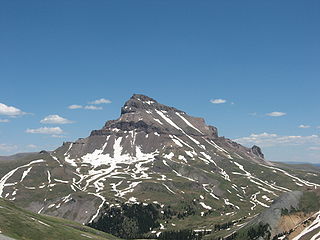
The San Juan Mountains is a high and rugged mountain range in the Rocky Mountains in southwestern Colorado and northwestern New Mexico. The area is highly mineralized and figured in the gold and silver mining industry of early Colorado. Major towns, all old mining camps, include Creede, Lake City, Silverton, Ouray, and Telluride. Large scale mining has ended in the region, although independent prospectors still work claims throughout the range. The last large scale mines were the Sunnyside Mine near Silverton, which operated until late in the 20th century and the Idarado Mine on Red Mountain Pass that closed down in the 1970s. Famous old San Juan mines include the Camp Bird and Smuggler Union mines, both located between Telluride and Ouray.

Telluride is the county seat and most populous town of San Miguel County in the southwestern portion of the U.S. state of Colorado. The town is a former silver mining camp on the San Miguel River in the western San Juan Mountains. The first gold mining claim was made in the mountains above Telluride in 1875, and early settlement of what is now Telluride followed. The town itself was founded in 1878 as "Columbia", but due to confusion with a California town of the same name, was renamed Telluride in 1887 for the gold telluride minerals found in other parts of Colorado. These telluride minerals were never found near Telluride, but the area's mines for some years provided zinc, lead, copper, silver, and other gold ores.

San Miguel County is one of the 64 counties of the U.S. state of Colorado. As of the 2020 census, the population was 8,072. The county seat is Telluride. The county is named for the San Miguel River.
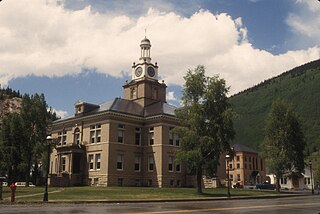
San Juan County is one of the 64 counties of the U.S. state of Colorado. As of the 2020 census, the population was 705, making it the least populous county in Colorado. The county seat and the only incorporated municipality in the county is Silverton. The county name is the Spanish language name for "Saint John", the name Spanish explorers gave to a river and the mountain range in the area. With a mean elevation of 11,240 feet (3426 meters), San Juan County is the highest county in the United States.

Ouray County is a county located in the U.S. state of Colorado. As of the 2020 census, the population was 4,874. The county seat is Ouray. Because of its rugged mountain topography, Ouray County is also known as the Switzerland of America.

The City of Ouray is the home rule municipality that is the county seat of Ouray County, Colorado, United States. The city population was 1,000 as of the 2010 census. The Ouray Post Office has the ZIP code 81427. Ouray's climate, natural alpine environment, and scenery has earned it the nickname, "Switzerland of America".

The Town of Ridgway is the home rule municipality that is the most populous municipality in Ouray County, Colorado, United States. The town is a former railroad stop on the Uncompahgre River in the northern San Juan Mountains. The town population was 713 at the 2000 census and 924 according to the 2010 census.

Edward Prentiss Costigan was a Democratic Party politician who represented Colorado in the United States Senate from 1931 to 1937. He was a founding member of the Progressive Party in Colorado in 1912.

Uncompahgre National Forest is a U.S. National Forest covering 955,229 acres in parts of Montrose, Mesa, San Miguel, Ouray, Gunnison, Hinsdale, San Juan, and Delta Counties in western Colorado. Only its headquarters is in Delta County, in the city of Delta. It borders the San Juan National Forest to the south.

Imogene Pass is a high mountain pass in the San Juan Mountains in the southwest part of the US state of Colorado.

Dallas Divide is a high mountain pass in the United States state of Colorado located on State Highway 62 about 12 miles (19 km) west of the town of Ridgway.
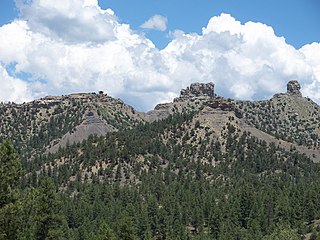
Chimney Rock National Monument is a 4,726-acre (1,913 ha) U.S. National Monument in San Juan National Forest in southwestern Colorado which includes an archaeological site. This area is located in Archuleta County, Colorado, between Durango and Pagosa Springs, and is managed for archaeological protection, public interpretation, and education. The Chimney Rock Archaeological Site has been listed on the National Register of Historic Places since 1970. U.S. President Barack Obama created Chimney Rock National Monument by proclamation on September 21, 2012 under authority of the Antiquities Act.

A guardhouse is a building used to house personnel and security equipment. Guardhouses have historically been dormitories for sentries or guards, and places where sentries not posted to sentry posts wait "on call", but are more recently staffed by a contracted security company. Some guardhouses also function as jails.
In the United States, a Mine Owners' Association (MOA), also sometimes referred to as a Mine Operators' Association or a Mine Owners' Protective Association, is the combination of individual mining companies, or groups of mining companies, into an association, established for the purpose of promoting the collective interests of the group. Such associations are sometimes referred to as MOAs, however, in some cases they may be designated by the state, district, or locale, such as the Cripple Creek District Mine Owners' Association (CCDMOA).

The following is an alphabetical list of articles related to the U.S. state of Colorado.
Emil B. Fischer published six detailed maps of the San Juan area of southwestern Colorado between 1883 and 1898. A surveyor’s son, he came to America around 1872. He moved to Durango in 1880 when the building of the Denver & Rio Grande Railway to the San Juan attracted widespread attention, then to Silverton. These maps aided silver and gold prospectors to file their claims; they enabled investors to locate mines and view their proximity to famous neighboring mines; and they encouraged tourists to visit the depicted mining regions and invigorate the local economies.
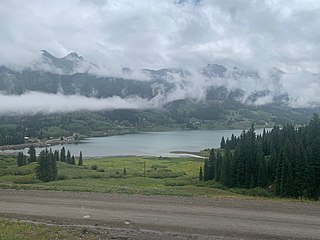
Trout Lake is a lake located in southeast San Miguel County, Colorado, in Uncompahgre National Forest. Trout Lake is a 15-minute drive from Ophir via Colorado State Highway 145 and a 30-minute drive from Telluride.

Mears Peak is a 13,496-foot-elevation mountain summit located on the common boundary of Ouray County with San Miguel County, in Colorado, United States. It is situated six miles northwest of the community of Telluride, in the Mount Sneffels Wilderness, on land managed by Uncompahgre National Forest. It is part of the Sneffels Range which is a subset of the San Juan Mountains, which in turn is part of the Rocky Mountains. Mears Peak is situated west of the Continental Divide, and 3.8 miles west of Mount Sneffels. Topographic relief is significant as the south aspect rises 4,900 feet (1,493 meters) above the San Miguel River in approximately 5.5 miles.
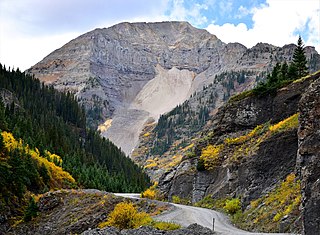
United States Mountain is a 13,036-foot-elevation mountain summit located in Ouray County of southwest Colorado, United States. It is situated six miles southwest of the community of Ouray, on land managed by Uncompahgre National Forest. It is part of the Sneffels Range which is a subset of the San Juan Mountains, which in turn is part of the Rocky Mountains. It is set west of the Continental Divide, 2.3 miles south of Potosi Peak, and 2.5 miles southeast of Stony Mountain. Recreation enthusiasts heading for Yankee Boy Basin traverse below the northern base of the mountain. Topographic relief is significant as the north aspect rises 3,300 feet (1,000 meters) above the Camp Bird Mine in approximately one mile. Mining activity in the immediate area produced significant amounts of gold and silver. The Hidden Treasure Mine is a gold mine located on the south slope at 11,759-feet elevation.

Chicago Peak is a 13,385-foot-elevation mountain summit located on the shared boundary of San Miguel County with Ouray County in southwest Colorado, United States. It is situated four miles east of the community of Telluride, on land managed by Uncompahgre National Forest. It is part of the Sneffels Range which is a subset of the San Juan Mountains, which in turn are part of the Rocky Mountains. It is set above the ghost town of Tomboy, one mile south of United States Mountain, and one mile northwest of Imogene Pass. Topographic relief is significant as the east aspect rises 2,000 feet (610 meters) above Imogene Basin in approximately one mile, and the west aspect rises 2,000 feet above Savage Basin in less than one mile. Mining activity in the immediate area produced significant amounts of gold and silver.





















